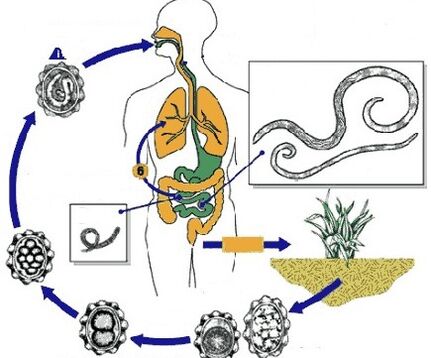
Helminthiasis is a group of parasitic diseases that progress as a result of the penetration of various types of parasitic worms into the body. These diseases are not limited in terms of gender and age. It is worth noting that helminthiasis is diagnosed more often in children. This is due to the fact that children are less hygienic, eat unwashed food and often play in the fresh air (sandpit, garden, etc. ).
Helminths are a group of representatives of the lower worms that are able to penetrate the human body and grow freely in it, thus provoking the progression of parasitic diseases. All representatives of this group can be conditionally divided into 3 groups:
- roundworms;
- tape;
- methyl.
Depending on the mode of transmission, all human helminthiases are subdivided into:
- biohelminthiasis.In this case, the parasite is transmitted by animals;
- contagious.Infection occurs from a sick person;
- geohelminthiasis.This type of helminthiasis is transmitted through the soil. This is due to the fact that a certain part of the life cycle of parasites occurs in the ground.
Larvae and developing forms of parasites are the most dangerous for the human body, as they can move freely on the body, infecting vital organs. Adults cannot move as freely and therefore have a more stable position.
Most species of helminths "prefer" to parasitize in the gastrointestinal tract. It is worth noting that different species are localized in different parts of the digestive tract: pinworms - in the lower part of the small intestine, roundworms - in its upper part, etc. Also, based on location, helminths are divided. of tissue and luminal.
It should be noted that parasites can infect not only the digestive tract, but also the lungs, bile ducts and the gallbladder itself. In the course of their lives, they release various toxic substances that poison the human body. It is important if you suspect the presence of parasites in the body, consult a doctor immediately and start treating the disease to avoid the development of dangerous complications.
Signs

The characteristic signs of helminthiasis are manifested primarily by peripheral blood. If you perform a clinical analysis, you can find a significant increase in the number of eosinophils (especially in the acute stage of the disease). It should be noted that eosinophilia is often combined with severe leukocytosis.
Other signs of helminths include:
- itching in the anus;
- possible unstable stools - alternating constipation and diarrhea;
- gnashing of teeth during sleep;
- morning sickness. It most often occurs in humans while brushing their teeth;
- weight loss until the diet has changed;
- hyperthermia accompanied by joint and muscle pain;
- drooling in the morning;
- man is constantly hungry;
- the appearance of elements of a rash on the skin (sometimes on the eyelids);
- The skin on your fingers may peel off.
Symptoms
The helminthiasis clinic is divided into acute and chronic stages. The first symptoms of helminthiasis appear a month after the parasites enter the body. The acute stage of the pathological process begins. The person experiences the following symptoms:
- diarrhea;
- hyperthermia;
- upper airways become inflamed;
- rash elements appear on the skin;
- conjunctivitis;
- The face swells. This symptom is especially pronounced in children;
- Young children sometimes have tonsillitis and lymphadenitis.
The pathological process can be complex:
- hepatitis;
- bronchospasm;
- the appearance of infiltrates in the lungs;
- pneumonia;
- meningoencephalitis;
- myocarditis.
The above symptoms do not occur simultaneously with any type of helminthiasis. Usually only two or three symptoms dominate in the clinic of the disease. Such a clinical picture in a patient is observed for 7 days, after which the disease becomes chronic. The signs of pathology vary depending on the type of pathogen that parasitizes in the human body:
- echinococcosis. The allergic reaction comes to the fore. Allergy symptoms are on top. In the most severe clinical situations, even anaphylactic shock may develop;
- filariasis and strongyloidiasis. The rash on the skin worsens and the face is swollen.
The onset of helminthiasis also largely depends on the location of the parasites. Most species parasitize in the gastrointestinal tract, leading to indigestion, weight loss, nausea, vomiting and intoxication syndrome.
Experts refer to the most severe helminthiasis:
- echinococcosis;
- paragonimiasis;
- cysticercosis.
These helminthiases affect almost all vital organs and systems, which is why even with timely treatment the prognosis is often unfavorable.
Diagnostics
Due to the fact that there is a fairly large number of helminthiases, the diagnosis involves many research methods. The most informative and frequently used are the following:
- stool analysis. In it, doctors have the opportunity to find helminth eggs, as well as undegraded food debris, which indicates a violation of the functioning of the gastrointestinal tract;
- blood on microfilariae;
- to detect roundworms and pinworms in the human body, resort to macroscopic examination;
- microscopic examination;
- bile tests;
- coprooscopy. Diagnosis of helminthiasis using this method allows you to determine the intensity of helminthic invasion;
- examination of the contents of the duodenum;
- if doctors suspect that a person is progressing to trichinosis, a biopsy of muscle tissue is prescribed;
- ultrasound;
- x-ray;
- fibrogastroduodenoscopy;
- blood test for specific antibodies to some helminthiases.
Treatment
The main goal of treatment of the disease is to expel the parasites from the patient's body, as well as to restore the normal functioning of the gastrointestinal tract. The treatment plan is prescribed only by a qualified specialist after a thorough diagnosis, evaluation of test results. The treatment can be performed both in a hospital setting and at home.
The basis of treatment of helminthiasis is the use of specific anthelmintic drugs.
They should only be taken as prescribed by your doctor and at the dose you prescribe. In the acute phase of the disease, a single dose of the drug is enough to get rid of helminths. But most often the treatment is carried out according to a certain scheme.
It is important to adhere to the following principles during treatment:
- strict observance of the rules of personal hygiene;
- dietary therapy;
- all products consumed must be processed;
- at the place where the patient is treated, it is necessary to disinfect regularly.
The treatment of helminthiasis in children is performed only in an inpatient setting, so that the doctor can constantly monitor the patient's condition and, if necessary, adjust the therapy. It is worth noting that the disease in children is more severe, so the course of treatment can be long.
Prevention
Prevention of helminthiasis in children and adults should be carried out throughout life. Since helminths live in the ground and can be transmitted by contact, you should observe hygiene as much as possible - wash your hands, use personal hygiene items, etc. It is also important to process fruits and vegetables well before eating. .
For prophylactic purposes, it is important to identify people infected with helminths in a timely manner. To this end, surveys of certain categories of adults (especially workers in the food sector, the medical sector, etc. ) are regularly conducted.






































